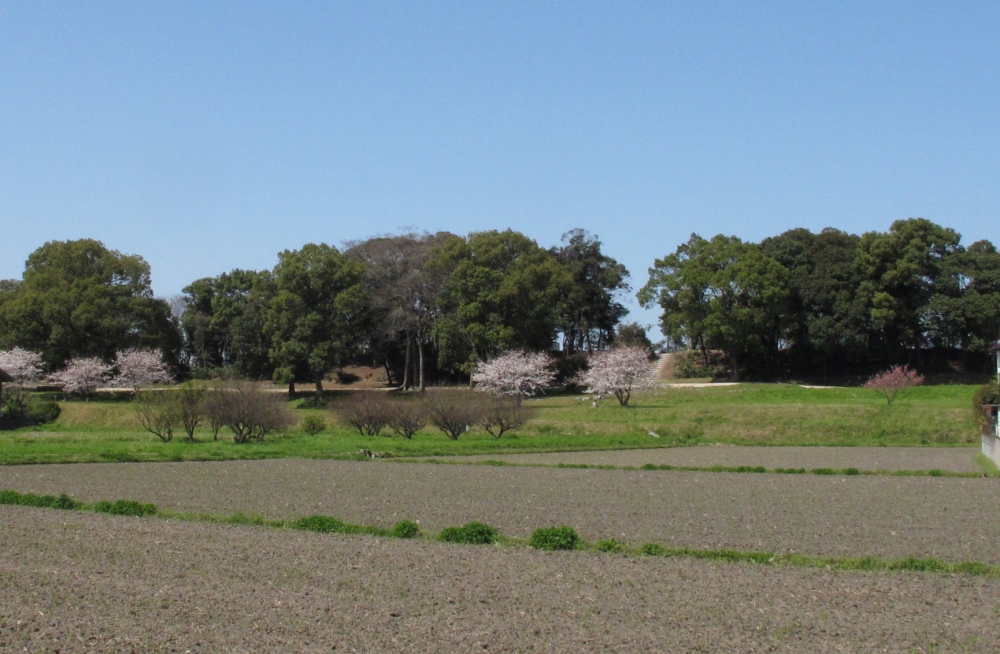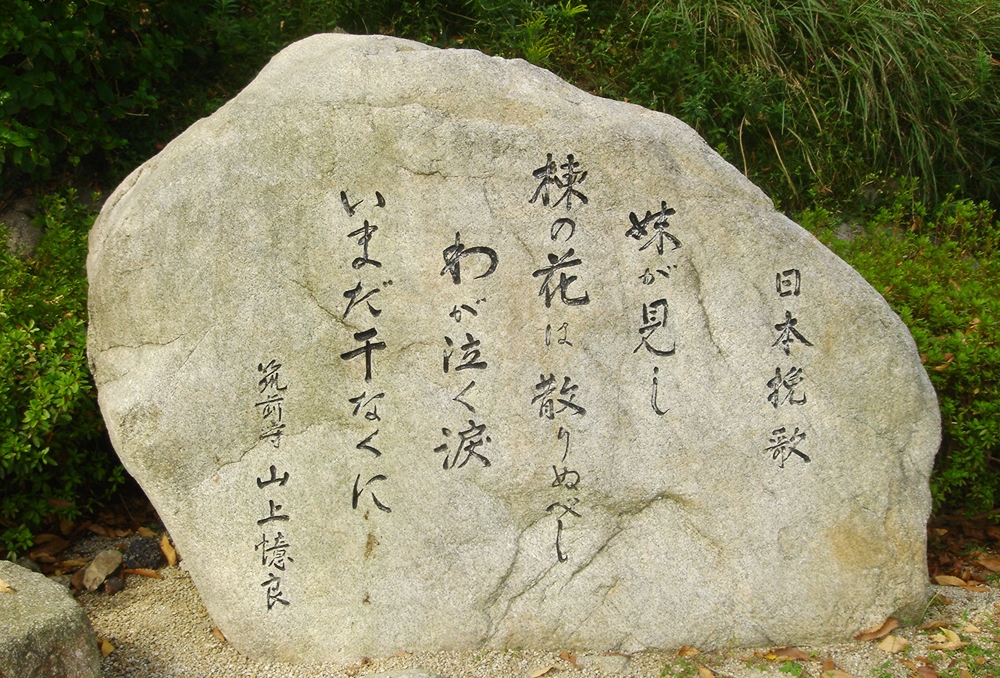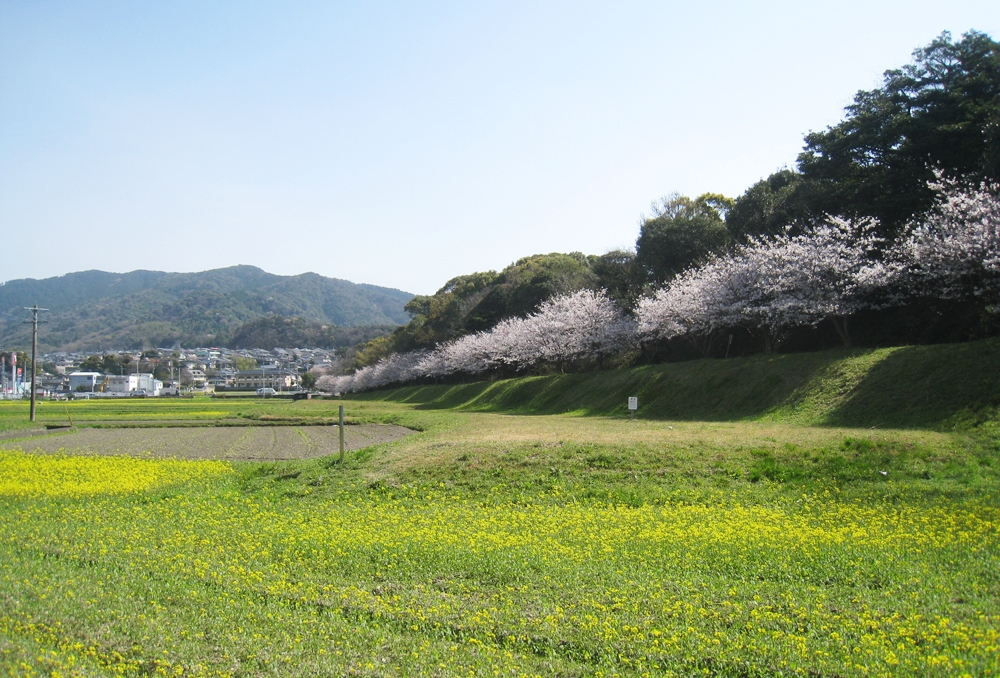Story-Composing Cultural Assets Mizuki Fortress Ruins
Ruins of Mizuki fortress (East gate area)
Mizuki was a fortress built in the year 664 to protect the northwest of Dazaifu.
It’s like “The Great Wall” of China, and it consisted of a 60m wide outer moat, and rammed earth wall ramparts of about 1.2km long, about 80m wide and about 9m high. This structure combined with geographic features around the area prevented entry from outside.
Two gates located in the east and west were for meeting and parting with people who came and left Dazaifu and many stories were born here.
More
Ruin of East Gate of Mizuki fortress (Kando East Gate Route)
These are the ruins of the East Gate of Mizuki fortress. There was a road connecting Hakata and Dazaifu, and was the final destination of “Sanyo-do road” from the capital to Dazaifu.
The highest ranking public servants who were sent from the Imperial Court were welcomed and were seen off by the public servants of Dazaifu.
More
Kinukake Shrine
This shrine tells a legend of Sugawara no Michizane who was demoted and came down to Dazaifu in the year 901.
On arriving in Mizuki, Michizane changed his traveling clothes into new clothes and hung his traveling clothes on a pine tree and a rock on the side. This shrine worships that pine tree and rock.
At the side of the entrance, there is the remains of “Sugatami-no-i” pond. Michizane was feeling deep sorrow seeing his emaciated face reflected in the pond. It has been said that the water in the pond immediately became muddy and never became clear again.
More

Ruins of Mizuki fortress (The Central Area)
Mizuki was a fortress built in the year 664 to protect the northwest of Dazaifu.
It’s like “The Great Wall” of China, and it consisted of a 60m wide outer moat, and rammed earth wall ramparts of about 1.2km long, about 80m wide and about 9m high. This structure combined with geographic features around the area prevented entry from outside.
Two gates located in the east and west were for meeting and parting with people who came and left Dazaifu and many stories were born here.
More
Ruin of West Gate of Mizuki fortress (Kando West gate Route)
These are the ruins of the West Gate of Mizuki fortress. A road connecting Dazaifu and Tsukushi-no-murotsumi (Koro-kan) Guesthouse lead here.
There were streams of people such as foreign delegates and Japanese envoys and monks waiting for their ships sailing to the Tang and Silla dynasties.
More

Man'yo Kahi (a monument inscribed with a poem)
About 320 waka were composed in Tsukushi and recorded in the Man'yoshu (Collection of Ten Thousand Leaves), the oldest existing collection of Japanese poetry.
There are some famous waka such as "Baika no En (Plum-blossom Party)" which was composed by public servants from provinces in the Saikai-do (Kyushu) Region at Sochi (Governor of Dazaifu) Otomo no Tabito’s official residence in Dazaifu. And also soldiers who were sent from the eastern provinces of Japan to fortify the border area, called Sakimori composed “Sakimori-no-uta” (waka of a soldier). Another famous waka is “Hinkyu mondo ka" (Dialogue on poverty) by Yamanoue no Okura about the distressing condition of the poor and about the collection of tax by the village chief. Besides these waka, there are many other waka describing scenes of Tsukushi region vividly.
These composers of waka are called “Tsukushi Manyo Kadan”.
Manyo Kahi (monuments inscribed with a poem) are located in various locations in the city and they are attracting many from other prefectures.
More






【National Special Historical Site】
This fortress was built to defend Japan after losing the war in support of the Baekje kingdom against Tang and Silla dynasties 1350 years ago.It consists of moats filled with water and mounds. Even now, a huge mound with a length of 1.2 km can be seen. It was built in the style of the Naseong city wall in Buyeo, capital of Baekje. Later, it became the entrance to Dazaifu, which welcomed many foreign delegations and government officials from the national capital. This was the setting for a number of stories from history.